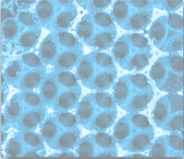Methane can be produced at decentralized refineries, conveniently stored and then distributed throughout natural gas networks. Therefore, it is considered a prime candidate for use in future sustainable energy systems.
The Sabatier Reaction generates methane using two relatively abundant feedstocks, carbon dioxide and hydrogen. Presently, the Sabatier reaction requires very high temperatures to progress. But given the ready availability of carbon dioxide and relatively easy access to hydrogen through the electrolysis of water, there is considerable interest in developing new and more efficient catalyst systems for it.
Many different catalysts, including titanium oxide and ruthenium, have been investigated for their activity in this reaction. Geoff Ozin describes his group’s development of a ruthenium oxide catalyst supported on 3D silicon photonic crystals. They demonstrate that under intense simulated sunlight their catalytic system is able to convert carbon dioxide to methane at a high rate.

The group shows that while the ruthenium oxide catalyst is able to perform the Sabatier reaction when suspended on a simple silicon wafer, the reaction rate is much higher when the catalyst is suspended on their specially designed 3D silicon photonic crystal. They hypothesize that this improved activity is due to a number of factors; their silicon photonic crystal has a much higher surface area to volume ratio than silicon wafer, and it also enables increased light absorption at particular wavelengths.
This work demonstrates, for the first time, that the unique light trapping attributes of a silicon photonic crystal, can be used to enhance and drive the Sabatier reaction. It’s hoped that these findings will drive further research into the development of this photoreactor system, to optimize its activity and light harvesting capacity.
Kindly contributed by Geoff Ozin, edited by Aaron Brown.

















